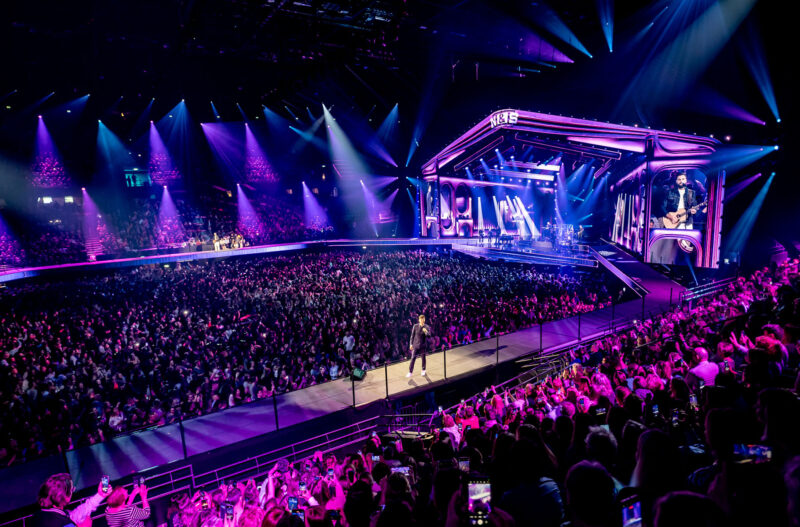
Phenomenally successful Dutch singer-songwriter duo Nick & Simon (Nick Schilder & Simon Keizer) played six sold-out nights at Rotterdam’s famous Ahoy Arena in The Netherlands, the culmination of their Nu of Ooit (Now or Someday) tour which also was the last time they will appear in this format, as after 17 years of performing together, both artists now intend to pursue solo careers.
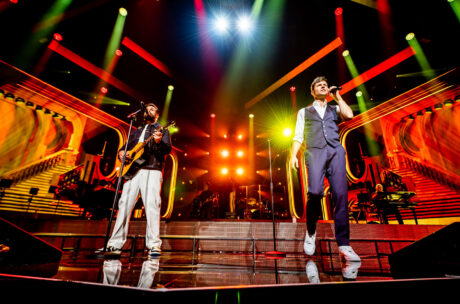 Lighting was designed by Martijn Steman of Triple Showtechniek working closely with artistic / show director Ad de Haan from Live Legends with the help of approximately 220 Robe moving lights on the live show rig, plus another 60 Robe Spiiders appearing as virtual light sources within the digital scenery that defined the stage design and show aesthetic.
Lighting was designed by Martijn Steman of Triple Showtechniek working closely with artistic / show director Ad de Haan from Live Legends with the help of approximately 220 Robe moving lights on the live show rig, plus another 60 Robe Spiiders appearing as virtual light sources within the digital scenery that defined the stage design and show aesthetic.
Jim de Brouwer from Live Legends created the set design in conjunction with Sander van der Ham of Bluepaper and creative Desiree van Giezen, which comprised 435 square meters of LED screen. The concept was to have a ‘museum’ building that houses all Nick & Simon’s hits – of which there are many – each in their own special place. With moving walls and stairs, the stage architecture could be shifted and varied, offering a unique scenic look for each song in the set.
De Haan explained that since 2009, when Live Legends first became involved in designing Nick & Simon’s stage environments, they have often included large LED surfaces enabling spectacular I-Mag close ups of the artists onscreen. For this one, they wanted to be able to change the scenery dramatically for each song, and digital scenery was a more cost-effective and flexible way of achieving this than doing it physically.
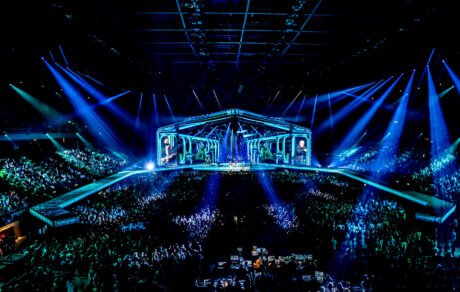 Live Legends’ content creation team – VFX artists Jim de Brouwer and Rolf Kuipers and content producer Margriet van Weperen – were asked to realistically light the footage they were making with plenty of motion using the virtual light sources. For the show, it was essential that the pace and atmosphere of the real and digital worlds and content were synchronized, so De Haan and Steman’s long and enjoyable experience of collaborating on Nick & Simon shows proved a great asset in merging these digital decor and lighting elements seamlessly into one visual entity.
Live Legends’ content creation team – VFX artists Jim de Brouwer and Rolf Kuipers and content producer Margriet van Weperen – were asked to realistically light the footage they were making with plenty of motion using the virtual light sources. For the show, it was essential that the pace and atmosphere of the real and digital worlds and content were synchronized, so De Haan and Steman’s long and enjoyable experience of collaborating on Nick & Simon shows proved a great asset in merging these digital decor and lighting elements seamlessly into one visual entity.
Once the set list was established, Van Giezen and Steman drew up a color list for 29 songs which had a total run time of one hour and 45 minutes. As the stage layout of the ‘museum’ changed, so did the lighting and video designs. By working with different angles of light, the different digital compositions were sometimes very theatrical for ballads and slow songs, but animated and up-tempo for the more rousing music.
Video was played back via a Resolume server with two live operators – Van Giezen took care of live Picture in Picture (PiP) inserts plus all the specials related to the LED banners along the catwalks and above the band, and lit the digital décor with three or four lighting looks for each song.
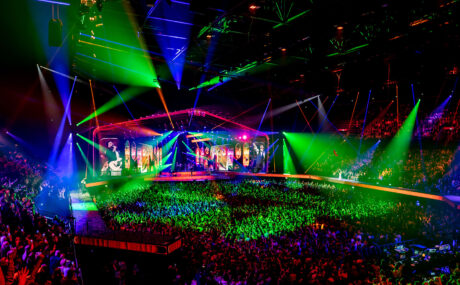 Steman has lit Nick & Simon since they first broke through in 2006. One of the beauties of working on these shows was collaborating closely with De Haan, van der Ham and Van Giezen and blending lighting and visuals so specifically, creating special scenes and perceptions of depth that intensified the live experience.
Steman has lit Nick & Simon since they first broke through in 2006. One of the beauties of working on these shows was collaborating closely with De Haan, van der Ham and Van Giezen and blending lighting and visuals so specifically, creating special scenes and perceptions of depth that intensified the live experience.
Of the 66 Robe MegaPointes on the shows, most were above the stage and along two runways that came off the stage either side and ran down the length of the auditorium. These were used as the show’s main effects lighting.
The 40 LEDBeam 150s were positioned along the sides of the LED screens so Steman could call them up for side lights, while 36 LEDBeam 350s were flown all around the room and used to backlight the audience and extend and echo the mood of the decor across the hall for a more immersive experience. Twenty-two real Robe Spiider LED wash beams were used as a backlight for the band. Steman needed a powerful, punchy, and even luminaire to compensate for the brightness of the LED screen.
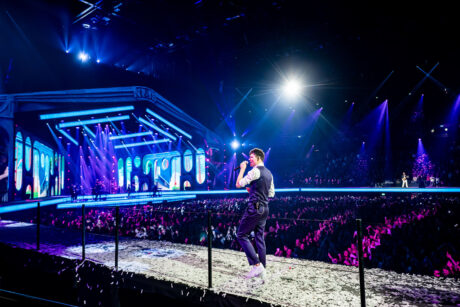 For front light he chose 20 BMFL Blades, picked for their power, excellent whites, and flesh tones, with four BMFL Spots – out of a total of 24 – used as remote followspots, running on four RoboSpot BaseStations positioned in a control room on the venue’s second floor balcony level. The four BMFL Spots were rigged along the runways and the front truss and were chosen for their output and because Steman specifically wanted to utilize the flexibility of the RoboSpot system for several reasons. The main one was that spot chairs dangling down from the rig, looking unsightly, and obscuring the clean high-impact structural look… was out. RoboSpots also allowed him to cover entrances at multiple points across the stage and set and gave him color and other parameter control that was at the core of the design concept, so they could be matched to the lighting and scenic ambience of the moment.
For front light he chose 20 BMFL Blades, picked for their power, excellent whites, and flesh tones, with four BMFL Spots – out of a total of 24 – used as remote followspots, running on four RoboSpot BaseStations positioned in a control room on the venue’s second floor balcony level. The four BMFL Spots were rigged along the runways and the front truss and were chosen for their output and because Steman specifically wanted to utilize the flexibility of the RoboSpot system for several reasons. The main one was that spot chairs dangling down from the rig, looking unsightly, and obscuring the clean high-impact structural look… was out. RoboSpots also allowed him to cover entrances at multiple points across the stage and set and gave him color and other parameter control that was at the core of the design concept, so they could be matched to the lighting and scenic ambience of the moment.
All the Robe lights together with another 200 or so fixtures were programmed and run by Steman on a Hog 4 console, run completely live with no timecode input. Prior to that, he prevized in Depence 3 using previews of the video content for reference. Lighting equipment was supplied via Steman’s company, Triple Showtechniek B.V which has supplied Nick & Simon’s management company, Volendam Music B.V., for some time.
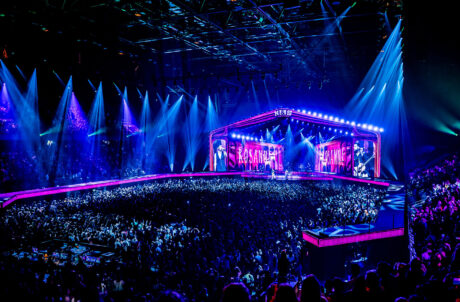 Quizzed on what he enjoyed the most about these shows, Steman stated “the collaborative nature” of the production and the fusion of talents and teamwork that made the stage come alive, etching lasting and memorable Nick & Simon impressions for all their fans. It was an emotional time for many after such a lengthy chapter in the creative careers of both artists, however there is also plenty of anticipation about what will happen next, as clearly neither of them is going away.
Quizzed on what he enjoyed the most about these shows, Steman stated “the collaborative nature” of the production and the fusion of talents and teamwork that made the stage come alive, etching lasting and memorable Nick & Simon impressions for all their fans. It was an emotional time for many after such a lengthy chapter in the creative careers of both artists, however there is also plenty of anticipation about what will happen next, as clearly neither of them is going away.
Further information from Robe lighting: www.robe.cz
Photos: Nico Alsemgeest


